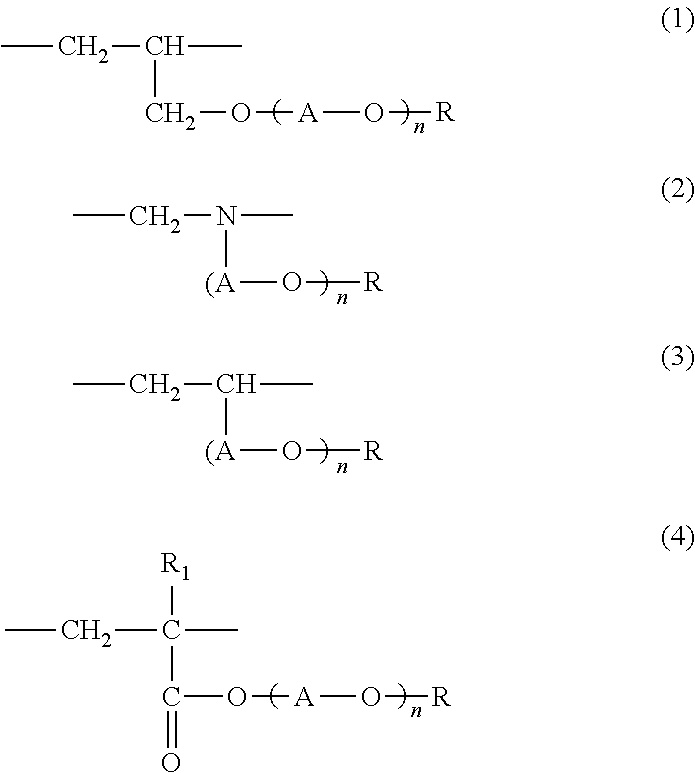Adhesive hydrogel and use thereof
a technology of adhesive hydrogel and hydrogel, which is applied in the direction of amide/imide polymer adhesives, non-macromolecular adhesive additives, adhesive types, etc., can solve the problems of reducing the effective adhesive area of the electrode pad, the hydrogel disclosed in patent document 1 fails to deliver sufficient adhesive strength, and the initial adhesive strength quickly loses much of its adhesive strength, etc., to achieve excellent adhesive strength, improve initial adhesive strength, and improve the effect of adhesive strength
- Summary
- Abstract
- Description
- Claims
- Application Information
AI Technical Summary
Benefits of technology
Problems solved by technology
Method used
Image
Examples
example 1
[0106]Acrylamide (18 parts by weight) as (meth)acrylamide and / or a (meth)acrylamide derivative (d) which is a monofunctional monomer, 0.03 parts by weight of N,N′-methylene bisacrylamide (MBAA) as a crosslinking monomer (a), 53.34 parts by weight of glycerin as a polyhydric alcohol, and 20 parts by weight of ion exchanged water were stirred and dissolved to prepare a monomer liquid mixture. 1-[4-(2-hydroxyethoxy)-phenyl]-2-hydroxy-2-methyl-propan-1-one (product name: IRGACURE® 2959, manufactured by BASF Japan Ltd.) (0.13 parts by weight) as a photo-radical polymerization initiator was added to the monomer liquid mixture, and the mixture was further stirred and dissolved.
[0107]Next, 0.5 parts by weight of a copolymer (trade name: “Aronvis® AH-305” manufactured by Nihon Junyaku Co., Ltd., weight-average molecular weight 4,500,000, identified as “AA / TBAS” in Table 1) of acrylic acid and tert-butylacrylamide sulfonic acid (TBAS) (copolymerization ratio=7:3; as another polymer component ...
example 4
[0110]Acrylic acid (11.5 parts by weight) (as at least one compound (b), which is part of a monofunctional monomer, selected from the group consisting of ethylenically unsaturated carboxylic acids, ethylenically unsaturated carboxylic acid salts, and ethylenically unsaturated carboxylic acid derivatives having a hydroxyl group, an acid group, a salt thereof, an amino group, and / or an ammonium group), 7.6 parts by weight of tert-butylacrylamide sulfonic acid (TBAS) as (meth)acrylamide and / or a (meth)acrylamide derivative (d) which is also a part of a monofunctional monomer, 2.4 parts by weight of N-vinyl-2-caprolactam as N-vinyl-2-caprolactam and / or N-vinyl-2-valerolactam (f) which is also a part of a monofunctional monomer, 0.06 parts by weight of N,N′-methylene bisacrylamide (MBAA) as a crosslinking monomer (a), 2.4 parts by weight of polyvinylpyrrolidone (Dai-ichi Kogyo Seiyaku Co., Ltd.; CREEJUS® K-30, K=29.2) as another polymer component containing a structural unit derived from...
PUM
| Property | Measurement | Unit |
|---|---|---|
| wt % | aaaaa | aaaaa |
| wt % | aaaaa | aaaaa |
| temperature | aaaaa | aaaaa |
Abstract
Description
Claims
Application Information
 Login to View More
Login to View More - R&D
- Intellectual Property
- Life Sciences
- Materials
- Tech Scout
- Unparalleled Data Quality
- Higher Quality Content
- 60% Fewer Hallucinations
Browse by: Latest US Patents, China's latest patents, Technical Efficacy Thesaurus, Application Domain, Technology Topic, Popular Technical Reports.
© 2025 PatSnap. All rights reserved.Legal|Privacy policy|Modern Slavery Act Transparency Statement|Sitemap|About US| Contact US: help@patsnap.com


